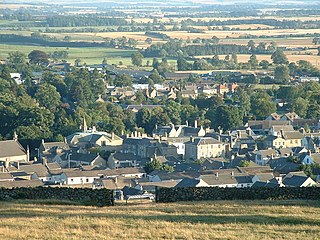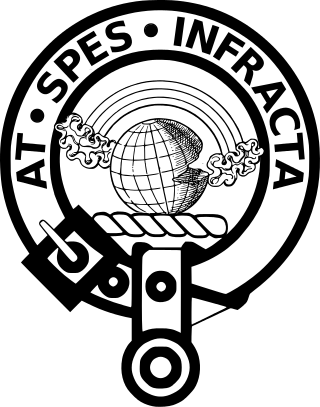Related Research Articles

Duns is a town in the Scottish Borders, Scotland. It was the county town of the historic county of Berwickshire.

Earl of Haddington is a title in the Peerage of Scotland. It was created in 1627 for the noted Scottish lawyer and judge Thomas Hamilton, 1st Earl of Melrose. He was Lord President of the Court of Session from 1616 to 1625. Hamilton had already been created Lord Binning in 1613 and Lord Binning and Byres, in the County of Haddington, and Earl of Melrose, in the County of Roxburgh, in 1619. These titles were also in the Peerage of Scotland. The title of the earldom derived from the fact that he was in possession of much of the lands of the former Melrose Abbey. However, Hamilton was unhappy with this title and wished to replace it with "Haddington". In 1627 he relinquished the earldom of Melrose and was instead created Earl of Haddington, with the precedence of 1619 and with limitation to his heirs male bearing the surname of Hamilton. This derived from the fact that he considered it a greater honour to take his title from a county rather than from an abbey. Hamilton was a member of the prominent Scottish family of that name and descended from John de Hamilton, younger son of Walter de Hamilton, who was granted the feudal barony of Cadzow and who is also the ancestor of the Dukes of Hamilton and Dukes of Abercorn.
Sir Richard Maitland of Lethington and Thirlstane was a Senator of the College of Justice, an Ordinary Lord of Session from 1561 until 1584, and notable Scottish poet. He was served heir to his father, Sir William Maitland of Lethington, East Lothian, and Thirlestane, Berwickshire, on 15 October 1515, his father being one of the casualties at the Battle of Flodden. He held the political office of Keeper of the Great Seal of Scotland and was also the Keeper of the Privy Seal of Scotland, from 1563 to 1567, and was succeeded in this post by his son Sir John Maitland, 1st Lord Maitland of Thirlestane.
Sir Patrick Hepburn of Dunsyre, 1st Lord Hailes was the feudal lord of Hailes and its castle in East Lothian and a Lord of Parliament.
Sir Robert Lauder of the Bass was a Scottish knight, armiger, and Governor of the Castle at Berwick-upon-Tweed. He was also a member of the old Scottish Parliament. The Lauders held the feudal barony of The Bass, East Lothian, Edrington Castle and lands in the parish of Mordington, Berwickshire, Tyninghame in Haddingtonshire, and numerous other estates and properties elsewhere in Scotland.

Cockburn is a Scottish surname that originated in the Borders region of the Scottish Lowlands. In the United States most branches of the same family have adopted the simplified spelling 'Coburn'; other branches have altered the name slightly to 'Cogburn'. The French branch of the family uses the spelling 'de Cockborne', with the middle "ck" being pronounced.

Clan Elphinstone is a Lowland Scottish clan.

Clan Home is a Scottish clan. It held immense power for much of the Middle Ages and dominated the eastern Scottish Borders. It produced no fewer than eight Wardens of the Eastern March – more than any other family.

Clan Hope is a Scottish clan of the Scottish Lowlands.

Sir John Lauder, 1st Baronet, of Newington and Fountainhall was a notable Scottish baillie and Treasurer of the City of Edinburgh Council, who was raised to a Nova Scotia baronetcy in 1688.
The Broun Baronets are a branch of the ancient Broun of Colstoun family whose estate near Haddington, East Lothian, remains to this day in the possession of a cadet family.
Sir Robert de Lawedre (Lauder) of Edrington & The Bass, Knt., was a Burgess of Edinburgh and a confidant of King Robert III and sometime Guardian of his son, the future James I of Scotland.
There have been two Cockburn baronetcies in the Baronetage of Nova Scotia.
Sir James Cockburn, 8th Baronet was a Member of the Parliament of Great Britain for Linlithgow Burghs from 1772 to 1784 and a Director of the East India Company.

Sir James Cockburn, 9th Baronet, of Langton, Berwickshire was British Governor of Bermuda from 1811 to 1812, from 1814 to 1816 and from 1817 to 1819.

Gavinton is a small settlement in the Scottish Borders area of Scotland, 2 kilometres (1.2 mi) south-west of Duns, the former county town of Berwickshire. The hamlet sits on a minor road off the A6105 Duns to Greenlaw road at grid reference NT767521.

Bonkyll Castle was a medieval fortress situated in the historic Scottish county of Berwickshire, from 1973 the Scottish Borders. It is situated 4 miles north of Duns and 4 miles south of Grantshouse. Few traces survive and the site is protected as a scheduled monument. It was the seat of a junior branch of the Stewart family, known as "Stewart of Bonkyl", from which was descended in another junior branch "Stewart of Darnley", the paternal family of King James VI & I of Scotland and England.

Langton Castle is a now destroyed medieval fortress at Langton, near the burgh of Duns, Berwickshire, Scotland. Little remains of the structure.
Cockburn Tower was a small fortified house in Berwickshire, Scotland. Now little more than the outline of a foundation, it occupied a site on the southern slope of Cockburn Law overlooking the Whiteadder Water. The foundations of the Tower trace a roughly square outline measuring 12.8 metres (42 ft) by 11.6 metres (38 ft), according to a survey conducted in 1980.

Skirling is a parish, community council area and village in Peeblesshire in the Scottish Borders situated 2+1⁄2 miles east of Biggar in Lanarkshire. Biggar Water, a tributary the River Tweed forms the southern boundary of the parish with the parish of Broughton, Glenholm and Kilbucho. It is also bounded by that parish on the east, namely the Broughton part of it. On the north it is bounded by the parish Kirkurd in Peeblesshire. Spittal Burn forms most of its western boundary with Lanarkshire.
References
- ↑ Thomas Cockburn-Hood, The house of Cockburn of that ilk and the cadets thereof: with historical anecdotes of the times in which many of the name played a conspicuous part, Scott and Ferguson, Edinburgh, 1888
- ↑ McAndrew, Bruce A., Scotland's Historic Heraldry, Boydell Press, Woodbridge, U.K., 2006, ISBN 1-84383-261-5.